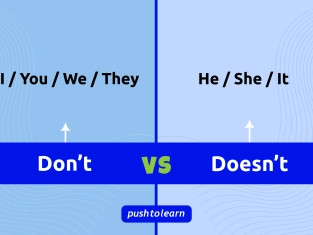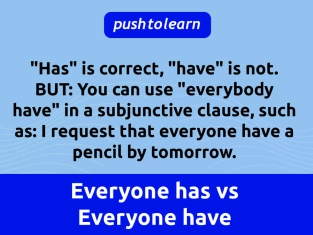by PushtoLearn
Has vs Have
Table of Contents
- Has vs Have Exercises
- The Basic Rule: Subject-Verb Agreement
- Theory and Rules
- Understanding Has and Have with Examples
- What Is the Difference Between Has and Have?
- When to Use Have
- When to Use Has
- Has vs. Have: A Summary Table
- Common Errors and How to Avoid Them
- Advanced Uses of Has and Have
- Past Tense: Had
- Frequently Asked Questions
Has vs Have Exercises
These exercises focus on Has vs Have
The Basic Rule: Subject-Verb Agreement
The choice between has and have depends on the subject of the sentence.
|
Subject Type |
Use |
Example |
|
He, She, It (third person singular) |
has |
She has a cat. |
|
I, You, We, They (all other subjects) |
have |
They have a dog. |

Theory and Rules
-
Has is used with third-person singular subjects:
-
He, She, It, or any singular noun.
-
Example: "He has a book."
-
Have is used with:
-
I, You, We, They, or any plural noun.
-
Example: "I have a question."
-
In questions and negative sentences, we use "have" with do/does:
-
Positive: "She has a bike."
-
Negative: "She does not have a bike."
-
Question: "Does she have a bike?"
Understanding Has and Have with Examples
Consider these two sentences:
-
Peter have a dog.
-
Peter has a dog.
Which one is correct? The answer is the second: Peter has a dog. But why? This depends on the subject of the sentence. Let’s explore the rules.
What Is the Difference Between Has and Have?
Both has and have come from the verb to have, which means:
-
To own or possess: “She has a bike.”
-
To experience: “They have fun at the park.”
-
To undergo: “He has surgery tomorrow.”
While both words mean the same thing, we use has and have differently based on the subject.
When to Use Have
Use have when the subject is:
-
I, we, you, or they (first-person, second-person, and third-person plural).
Examples:
-
I have a big family.
-
You have an interesting idea.
-
We have plenty of time.
-
They have new books.
Have is also used in questions and negative sentences with do/does:
-
Do you have any plans?
-
She does not have a ticket.
When to Use Has
Use has when the subject is:
-
He, she, it, or a singular noun (third-person singular).
Examples:
-
He has a new job.
-
She has a beautiful voice.
-
It has sharp claws.
-
The child has a fever.
Has vs. Have: A Summary Table
|
Subject |
Use |
Example |
|
I, We, You, They |
Have |
"We have a solution." |
|
He, She, It, Singular Noun |
Has |
"She has a brother." |
Common Errors and How to Avoid Them
-
Using "have" instead of "has" with singular subjects:
-
Incorrect: She have a car.
-
Correct: She has a car.
-
Using "has" with plural subjects:
-
Incorrect: They has a plan.
-
Correct: They have a plan.
-
Mistakes in negative sentences:
-
Incorrect: He doesn’t has any homework.
-
Correct: He doesn’t have any homework.
Advanced Uses of Has and Have
Collective Nouns
Collective nouns (like team, family, or company) can use has or have depending on the context:
-
The team has a new coach. (team as a single unit)
-
The team have different opinions. (team as individuals)
Modal Verbs
After modal verbs (e.g., can, should, must), always use have, regardless of the subject:
-
She should have called earlier.
-
They must have forgotten the address.
Past Tense: Had
The past tense of both has and have is had. Use had for all subjects:
-
He had a dog when he was young.
-
They had a great time at the party.
Frequently Asked Questions
What is the difference between has and have?
Has is for singular third-person subjects (he, she, it), while have is for all other subjects (I, we, you, they).
Can I use "has" with "I"?
No, always use have with "I." Example: "I have a dream."
Is it "he has" or "he have"?
The correct form is "he has."
Why do we use "have" after modal verbs?
Modal verbs require the base form of the verb, so we always use have, not has, after them. Example: "She might have known."
What is the negative form of has?
The negative form is does not have. Example: "She does not have a car."

